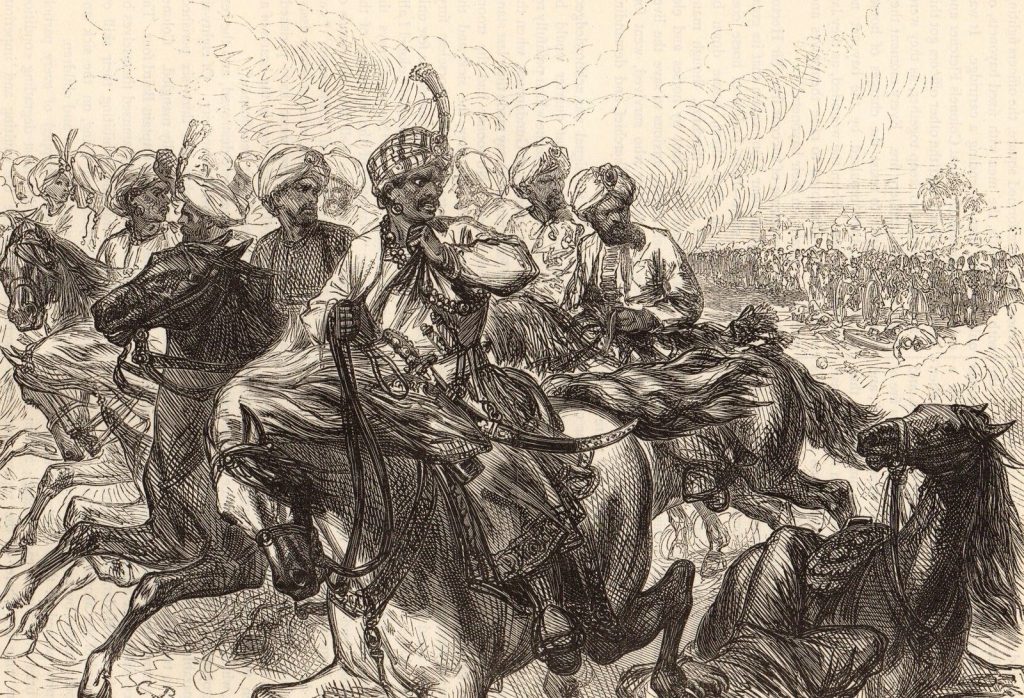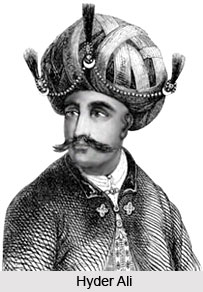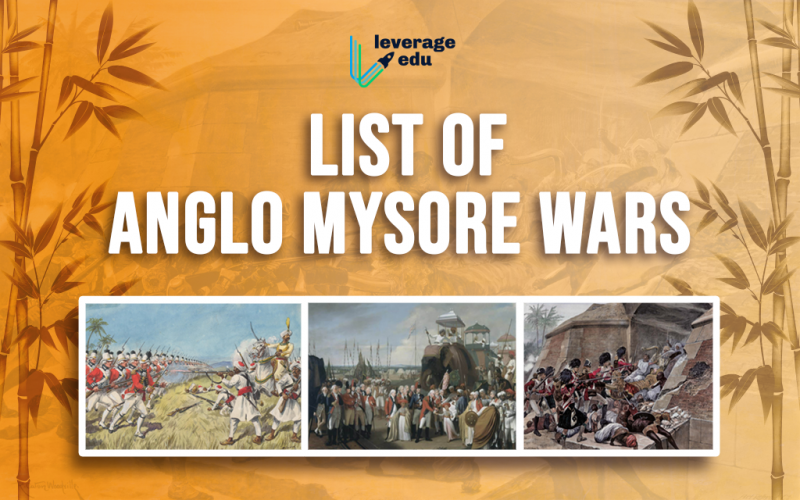Anglo Mysore Wars refers to a series of 4 wars that took place in the late 18th Century between the Kingdom of Mysore and the British in Southern India. The Anglo Mysore Wars occupies a significant place in the Modern Indian History context. In this blog, we shall discuss the four Anglo Mysore Wars that took place in India.
| Timeline | Dates |
| 1st Anglo Mysore War | 1767-1769 |
| 2nd Anglo Mysore War | 1780-1784 |
| 3rd Anglo Mysore War | 1790-1792 |
| 4th Anglo Mysore War | 1798-1799 |
Decoding the Battle of Plassey of 1757!

1st Anglo Mysore War [1767-1769]
In 1612, the Wodeyars established a Hindu state in the Mysore region. From 1734 to 1766, Chikka Krishnaraja Wodeyar II governed. With his tremendous administrative skills and military tactics, Haider Ali, a soldier in the army of the Wodeyars, became the de-facto king of Mysore. Under his guidance, Mysore became a strong force in the second part of the 18th century. The English political and commercial interests, as well as their influence over Madras, were jeopardised by Mysore’s proximity to the French and Haidar Ali’s dominance over the lucrative Malabar coast trade. After defeating the Nawab of Bengal in the Battle of Buxar, the British persuaded the Nizam of Hyderabad to sign a treaty giving them the Northern Circars in exchange for safeguarding the Nizam against Haidar Ali, who was already embroiled in a feud with the Marathas. Against Haidar Ali, the Nizam of Hyderabad, the Marathas, and the English banded together. Haider used diplomacy to keep the Marathas neutral and transform Nizam into an ally in the fight against the Nawab of Arcot.
What Was the Reason?
The annexation of regions in the South including Bidnur, Canara, Sera, Malabar, and Sunda by the strong army built by Hyder Ali for which he took support from the French. This alarmed the British.
What Happened During the War ?
- The British declared a war on Mysore along with the Marathas and the Nizam of Hyderabad.
- Hyder Ali with the help of his skilful diplomacy brought the Marathas and the Nizam to his side and paid the Marathas to turn them neutral.
- This war continued for more than a year without any conclusion
Result
- The war finally ended on 4th April, 1769 with the signing of the Treaty of Madras between Hyder Ali and the British.
- The territories that were conquered during the war were restored to each other
- They agreed to help each other in case of foreign attacks also.
Battle of Buxar: Significance, Causes and Aftermath
2nd Anglo Mysore War [1780-1784]
When the Maratha army attacked Mysore in 1771, the British failed to follow the treaty of Madras. Haider Ali accused them of betraying their trust. Furthermore, Haider Ali found the French to be more resourceful in meeting the army’s needs for firearms, saltpetre, and lead. As a result, he began bringing French war supplies to Mysore via Mahe, a French territory on the Malabar Coast. The British were concerned about the growing friendship between the two. As a result, the British attempted to seize Mahe, which was protected by Haider Ali.
What Was the Reason?
- Mysore was attacked in 1771 by the Marathas and the British did not provide support to Hyder Ali like they had agreed upon in the Treaty of Madras.
- As a result, Hyder Ali’s territories were conquered by the Marathas which further angered Hyder Ali against the British.
- When Mahe, a French possession under Hyder Ali’s dominion was attacked by the British, he declared war on the British in 1780.
What Happened During the War ?
- An alliance was formed by Hyder Ali with the Nizam and the Marathas and they defeated the British forces in Arcot
- Although, Hyder Ali died in 1782, the war was continued by his son Tipu Sultan
- The war was ended inconclusively by Sir Eyre Coote, with the Treaty of Mangalore.
Result
- According to the Treaty of Mangalore signed on 11 March 1784, the captured territories and prisoners were agreed to return to each other by both the parties.
Decoding Simon Commission
Hyder Ali in Anglo Mysore Wars

Haider Ali (1721-1782), a horseman in the Mysore army under the ministers of king Chikka Krishnaraja Wodeyar, began his career as a horseman in the Mysore army. He was illiterate, yet he was intelligent, diplomatically and militarily capable. With the support of the French army, he became the de facto king of Mysore in 1761 and incorporated western methods of training into his army. In 1761-63, he took over the Nizami army and the Marathas and captured Dod Ballapur, Sera, Bednur, and Hoskote, as well as bringing the troublesome Poligars of South India to surrender (Tamil Nadu). From the time of the Vijayanagara Empire in areas of Southern India, Poligars or Palaiyakkarars were appointed as military chiefs and administrative administrators. They also took money from the cultivators in the form of taxes. After recovering from their defeat, the Marathas led by Madhavrao attacked Mysore in 1764, 1766, and 1771, and defeated Haidar Ali. Haidar Ali had to pay them significant sums of money to buy peace, but after Madhavrao’s death in 1772, Haidar Ali raided the Marathas several times between 1774 and 1776, recovering all of the lands he had previously lost as well as capturing new territory.
Non-Cooperation Movement: Features, Causes and Results
3rd Anglo Mysore War [1790-1792]
The third Anglo–Mysore War (1790–1792) was fought in South India between the Kingdom of Mysore and the British East India Company, as well as the Kingdom of Travancore, the Maratha Empire, and the Nizam of Hyderabad. It was the third in a series of four Anglo–Mysore Wars. The third Anglo Mysore war took place when Cornwallis arrived in India as the Company’s governor-general. Tipu was an ardent opponent of the English. He was attempting to form alliances with foreign nations against the English and had dispatched diplomats to France and Turkey to that end. Cornwallis was thus persuaded of the necessity of subduing Tipu and referred to the battle against him as a “sad necessity.” Before launching the war on Tipu, Cornwallis took every care. He had talks with both the Marathas and the Nizam of Hyderabad. In June 1790, the Marathas signed a contract with the English, and in July 1790, with the Nizam. Both supported and helped the English in their fight against Tipu. It was also decided that the captured area would be split among the three allies. Though the English bore the brunt of the hardship of the battle, they were guaranteed that Tipu would be left alone to fight them. In 1790, the English launched the third war against Tipu Sultan.
What Was the Reason?
- With the British making efforts to improve their relationship with the Nizam of Hyderabad and the Marathas, Tipu Sultan, who had assumed control of Mysore after his father, Hyder Ali’s death, took the help of the French to better his military resources.
- Tipu Sultan went against the Treaty of Mangalore and refused to free the English prisoners taken during the second Anglo-Mysore war.
What Happened During the War ?
- A war was declared on Travancore, a friendly state of the British, in 1789 by Tipu Sultan.
- Following which, the Governor-General of Bengal, Lord Cornwallis declared war on Tipu, in 1790.
- In the first phase of the war Tipu Sultan was defeated and his forces had to retreat.
- Later when the British advanced towards Tipu Sultan’s capital of Seringapatam, he had to bargain for peace.
Result
- The war ended with the Treaty of Seringapatam in 1792, according to which Tipu Sultan had to surrender half of his kingdom to the British which included areas of Malabar, Dindigul, Coorg and Baramahal.
- He was also asked to pay a hefty amount of Rs.3 Crore as war indemnity to the British and surrender two of his sons as surety to the British till he paid his due.
Know everything about the Revolt of 1857
4th Anglo Mysore War [1798-1799]
Both the British and Tipu Sultan utilized the years 1792-99 to recover their losses. Tipu fulfilled all of the Treaty of Seringapatam’s conditions and had his sons liberated. When the Hindu monarch of the Wodeyar dynasty died in 1796, Tipu declared himself Sultan and resolved to avenge his humiliating defeat in the preceding battle. Lord Wellesley, a staunch imperialist, took over as Governor-General in 1798, succeeding Sir John Shore. Wellesley was concerned about Tipu’s burgeoning connection with the French. With the goal of destroying Tipu’s autonomous existence, he drove him into surrender via the Subsidiary Alliance structure. Tipu was accused and convicted with treasonable planning against the British by sending emissaries to Arabia, Afghanistan, the Isle of France (Mauritius), and Versailles. Wellesley was not convinced by Tipu’s argument, and thus the fourth Anglo-Mysore war started.
What Was the Reason?
- The Treaty of Seringapatam couldn’t assure peace between Tipu and the British.
- Tipu refused to accept the Subsidiary Alliance proposed by Lord Wellesley.
- Tipu further went on to get aligned with the French which was seen by the British as a threat.
What Happened During the War ?
- Mysore was attacked from all four sides with the invasion by Marathas and the Nizam from the North.
- As a result, Tipu’s troops were outnumbered.
- The British secured a victory at the Battle of Seringapatam in 1799.
- In the course of the war, Tipu died defending the city.
Result
- The British divided Tipu’s territories between them and the Nizam of Hyderabad.
- The Wodeyar dynasty who had been ruling Mysore before Hyder Ali got control of the core area around Seringapatam and Mysore .
- Mysore entered into a Subsidiary Alliance with the British with the placement of a British resident at the Mysore Court.
Post War Scenario
- Kanara, Wayanad, Coimbatore, Dwaraporam, and Seringapatam were all taken over by the British.
- The new kingdom of Mysore was given to the previous Hindu dynasty (Wodeyars) by Krishnaraja III, a minor king who accepted the subsidiary alliance.
- Lord Wellesley offered the Marathas the regions of Soonda and Harponelly in the Mysore Kingdom, which they declined.
- The districts of Gooty and Gurramkonda were handed to the Nizam.
Rowlatt Act: Timeline, Reasons and Result
MCQs on Anglo Mysore Wars
British control in South India was established with the end of the four Anglo-Mysore Wars. Many questions on the Anglo-Mysore Wars are posed in many competitive examinations that are held each year. As a result, we have compiled the top ten most often asked questions on the Anglo-Mysore Wars.
- What was the chronology of the second Anglo-Mysore war?
A. 1780 – 1784 AD
B. 1767 – 1769 AD
C. 1782 – 1785 AD
D. 1761 – 1765 AD
- What was the chronology of the fourth Anglo-Mysore war?
A. 1786 – 1788 AD
B. 1790 – 1792 AD
C. 1798 – 1799 AD
D. 1798 – 1800 AD
- When did Hyder Ali sit on the throne of Mysore?
A.1764 AD
B. 1761 AD
C. 1763 AD
D. 1756 AD
- Who was the British Governor-General during Third Anglo-Mysore War?
A. Lord Cornwallis
B. Lord Dalhousie
C. Lord Wellesley
D. Lord Warren Hastings
- Where is the Tomb of Tipu Sultan located?
A. Coimbatore
B. Dharapuram
C. Wayanad
D. Srirangapatna
- Which of the following Anglo – Mysore wars came to an end by the Treaty of Seringapatam?
A. First
B. Second
C. Third
D. Fourth
- Who was the British Governor-General during the Fourth Anglo-Mysore War?
A. Sir John Shore
B. Lord Wellesley
C. Sir John Macpherson
D. Lord Warren Hastings
- Who was the British Governor-General during the first Anglo-Mysore war?
A. Lord Ripon
B. Lord Verelst
C. Lord Lytton
D. Lord Wellesley
- Who was the British Governor-General during the Second Anglo-Mysore War?
A. Lord Ripon
B. Lord William Bentinck
C. Lord Warren Hastings
D. Lord Wellesley
- Tipu Sultan died during which Anglo-Mysore war?
A. First
B. Second
C. Was exiled to Kolkota
D. Fourth
Answers
- A
- C
- B
- A
- D
- C
- B
- B
- C
- D
Important Questions and Answers on Anglo Mysore Wars
The Kingdom of Mysore and British in Southern India
1767-1769
Hyder Ali was the Muslim ruler of Mysore and the military commander who played an important part in the wars in southern India in the mid-18th century.
The Treaty of Madras was signed between Hyder Ali and the British.
Tipu Sultan was the son of Hyder Ali who fought the third and fourth Anglo Mysore War and died while defending his city in the fourth war.
After the death of his father, Hyder Ali in 1782, Tipu Sultan took over the throne.
The 2nd Anglo Mysore War took place from 1780-1784.
The Treaty of Mangalore was signed thus marking the end of the 2nd Anglo Mysore War.
The 3rd Anglo Mysore War took place from 1790-1792.
Tipu Sultan died defending the city during the 4th War.
In total, 4 wars occurred in Mysore.
The first Anglo-Mysore war was won by the Kingdom of Mysore.
Mysore’s capital was taken by the British. Tipu Sultan, the ruler, was killed in the fight.
The “Treaty of Salbai” was signed on May 17, 1782, by representatives of the [Maratha Empire] and the [British East India Company] following protracted talks to resolve the outcome of the [First Anglo-Maratha War] between Warren Hastings and Mahadaji Scindia.
Hope you understood the reasons, consequences, and aftermath of the famous Anglo Mysore Wars with this blog. For more such informative content, stay tuned with Leverage Edu.

 One app for all your study abroad needs
One app for all your study abroad needs




















 45,000+ students realised their study abroad dream with us. Take the first step today.
45,000+ students realised their study abroad dream with us. Take the first step today.

